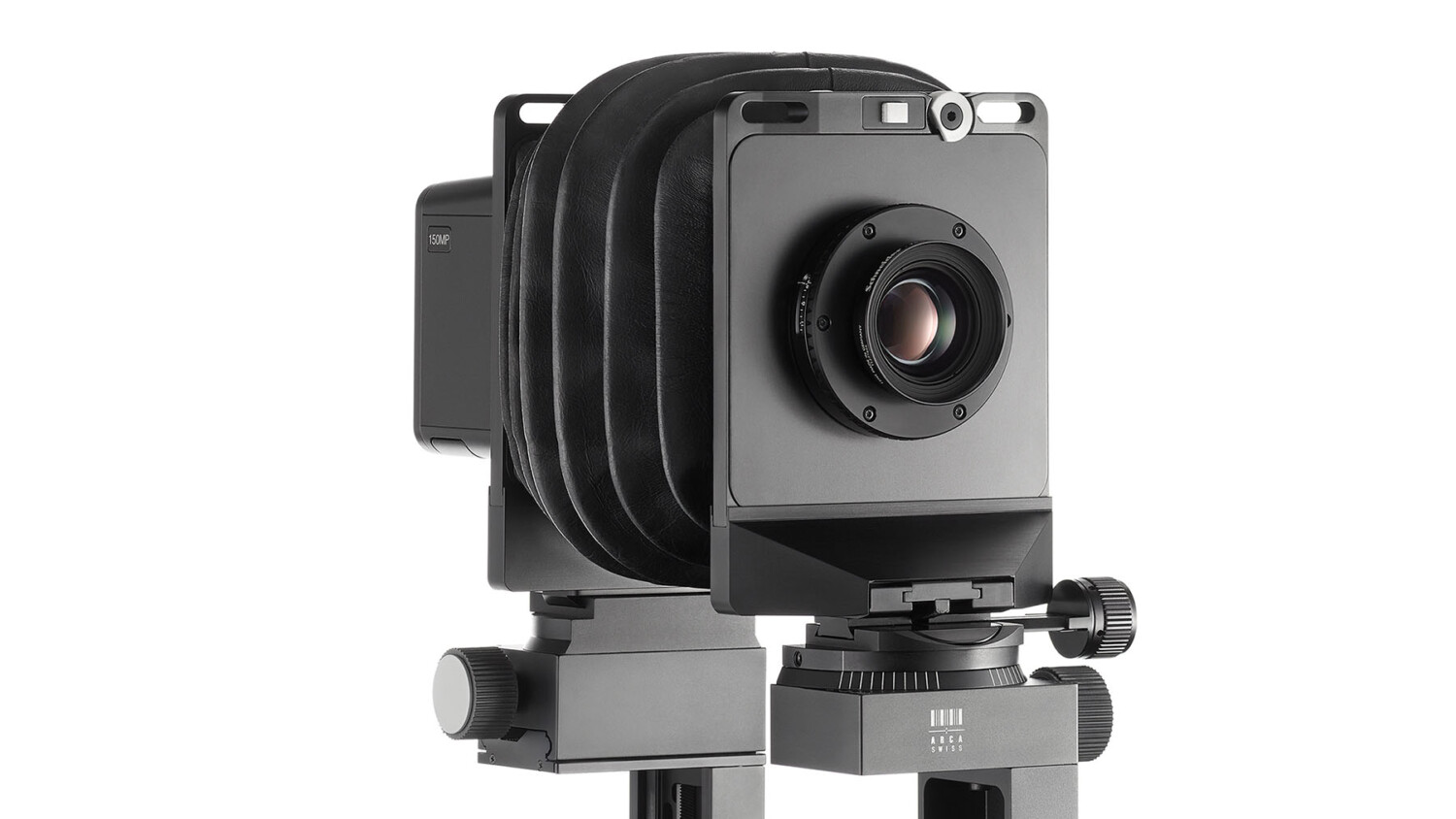A Beginner’s Guide to Technical Cameras
A technical camera is a highly specialized photographic tool designed for precision and versatility, featuring extensive movements such as tilt, shift, rise, fall, and swing. These cameras are used in architectural photography to achieve meticulous control over perspective and depth of field. But they are also an indispensable tool for other photo genres like landscape, product, or fine art photography. Unlike DSLR, mirrorless, or rangefinder cameras, technical cameras allow photographers to correct distortions, maintain straight lines, and achieve sharp focus across vast scenes or complex structures. This capability is crucial for capturing the intricate details and true representation of buildings and natural landscapes, thus elevating the quality and accuracy of the final image.
I have been researching the switch from a mirrorless system to a technical camera for several months. Since I have found hardly any information on the subject of technical cameras during my research, I would like to share with you what I found through other blogs, forums, and manufacturers’ websites.
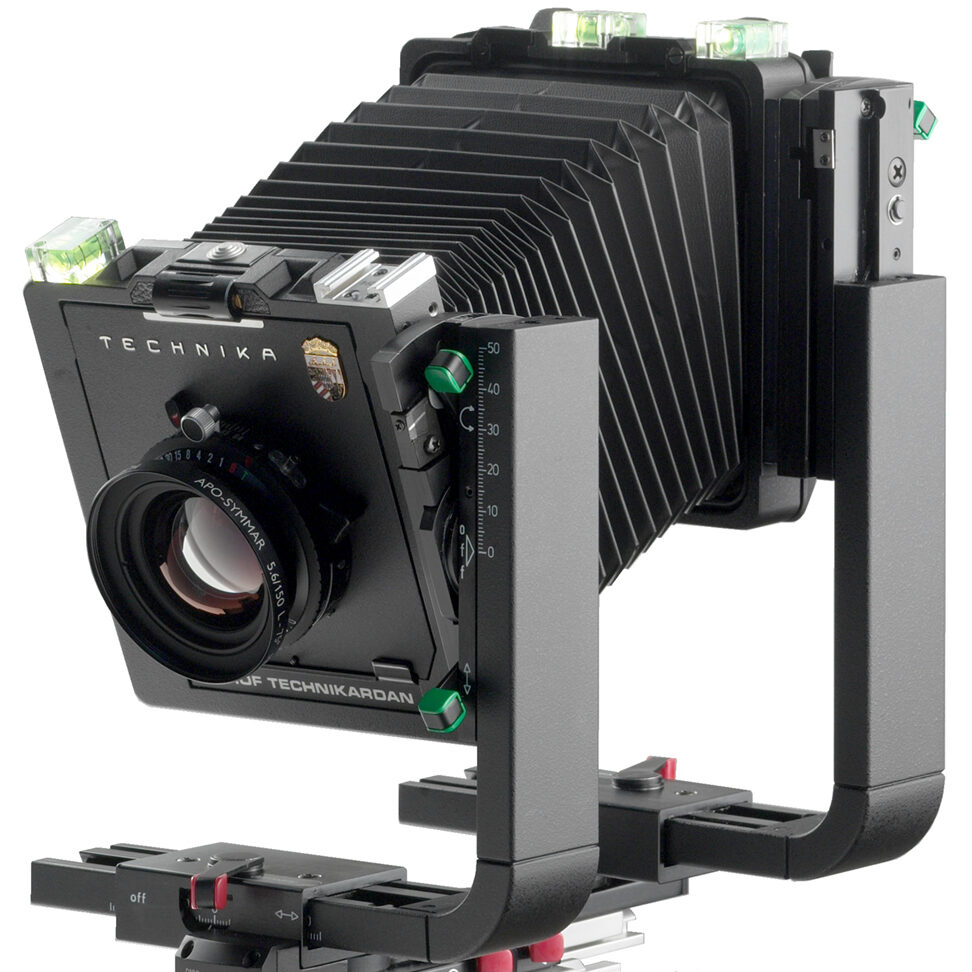
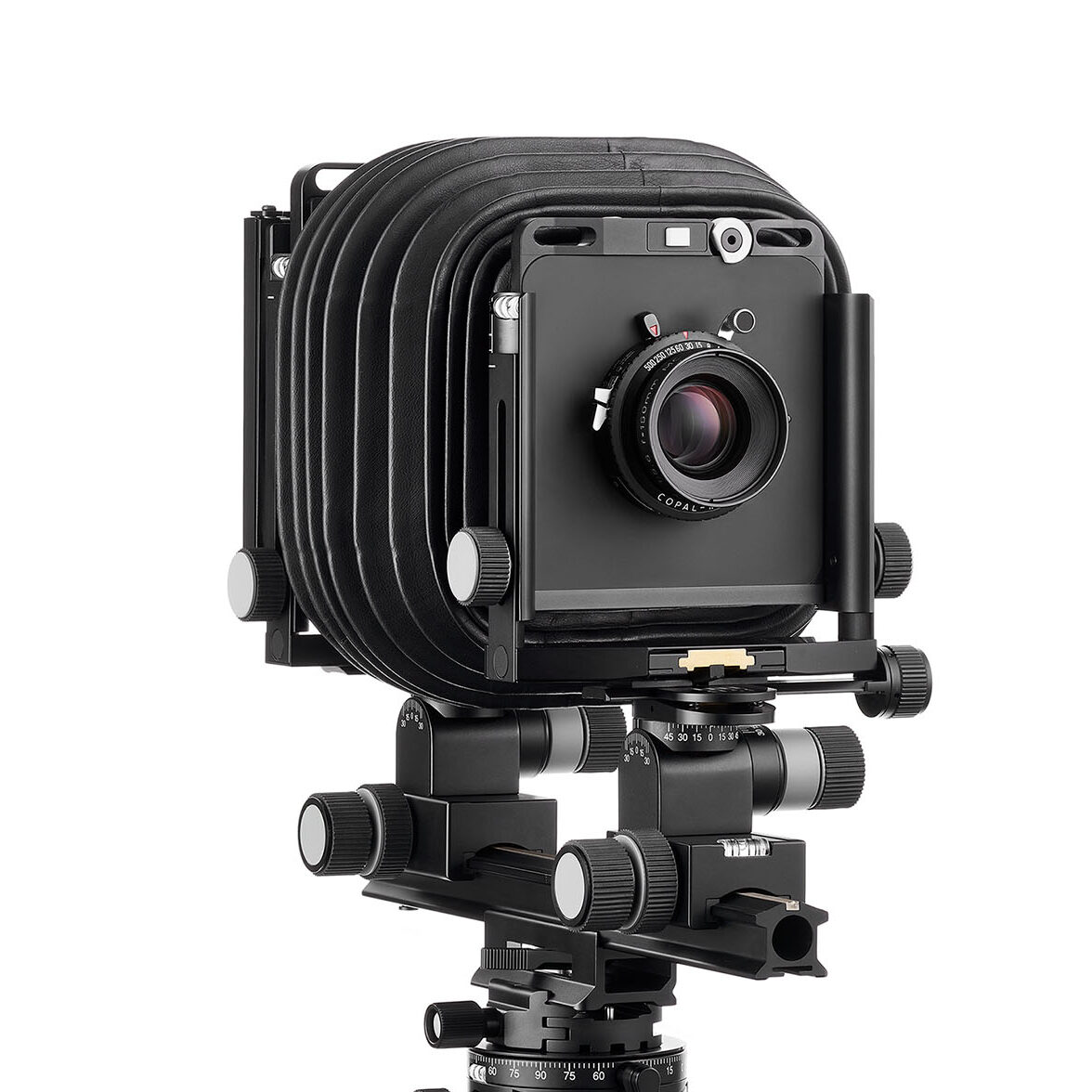
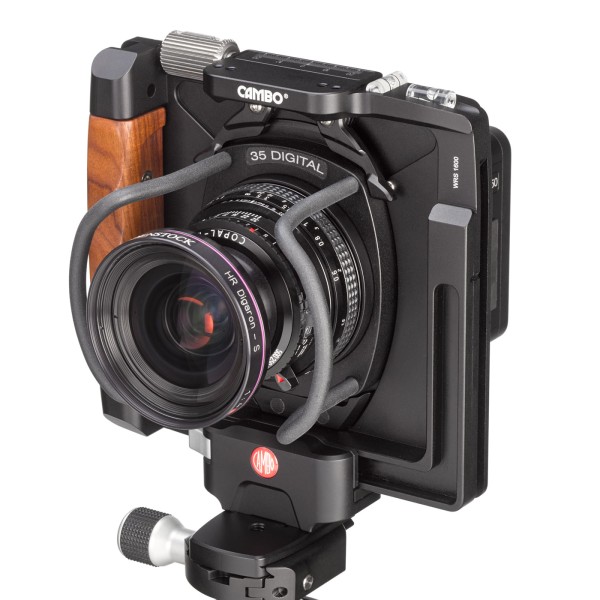
1. Types of Technical Cameras
Technical cameras come in various types, each tailored to specific photographic needs: view cameras, field cameras, and flatbed cameras.
View cameras, with their extensive range of movements and large format capabilities, are often used in studio settings where precision and detailed adjustments are paramount. Field cameras, designed for portability, offer a more compact and lightweight solution while still providing significant movement controls, making them ideal for outdoor and on-location shoots. Flatbed cameras offer a rigid design without a bellow system that allows for precise movements and flexibility, also more suitable for field use but they lack some separate front and rear adjustments for tilt and swing as they only operate on one layer. Although, cameras like the ARCA-SWISS Rm3di have built-in tilt/swing features. By using a thinner design, flatbed cameras can accommodate more wide-angle lenses than bellow cameras.
| Type | Unique Characteristics | Typical Use Scenarios | Pros | Cons |
| View Camera | Extensive movements, large format, bellows system | Studio photography, architectural, and fine art | Maximum control over perspective and depth of field, high image quality for large format photography | Bulky, heavy, complex setup, less portable |
| Field Camera | Compact, lightweight, foldable bellow system | Outdoor and on-location shoots | Portability, ease of use, faster setup, | Still bulky and somewhat complex in setup but easier that view cameras |
| Flatbed Camera | Rigid, compact design, easy to set up | Most compact design for on-locations shoots | Most compact design for on-location shoots | Less movement than view cameras, slower focusing |
Each type of technical camera offers distinct advantages and is suited for specific tasks, allowing photographers to choose the right tool for their particular needs.
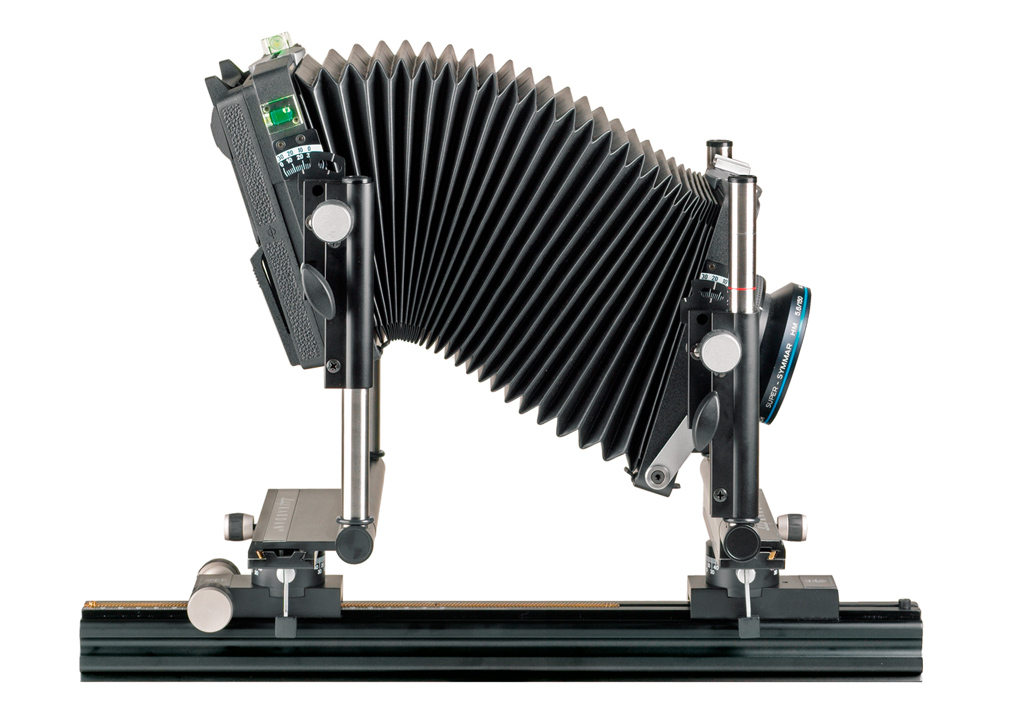
2. Components and Features:
Technical cameras offer a modular design that can be adapted to your individual needs. You can adapt digital backs, mirrorless cameras, slide film, or film plates to the camera. Different bellow options open up the possibilities for extensive macro photography and depending on the capture medium you can use a wide variety of new and vintage lenses with the system.
- Bellows: Flexible, accordion-like section that connects the lens to the film or sensor plane, allowing for significant adjustments. Bellows are used for view cameras and field cameras to focus the lens. Far focus is reached by retracting the bellow and close focusing by extending it. This way you can focus very closely with a long bellow system. Conversely, it is sometimes impossible to reach infinity focus with wide-angle lenses because the bellow system is too large to reach infinity on certain lens-sensor-combinations.
- Rail: Base for all parts of the camera. Front standard is sliding on the rail for focus.
- Front and Rear Standards: These hold the lens and the film/sensor, respectively, and can be independently moved and adjusted. This is where you set your tilt, shift, rise, fall, and swing movement. For flatbed cameras, the lens is attached to a helical focusing mount that is connected to the camera mount. This leaves only one layer of movement for shift and rise/fall.
- Lens Boards: Removable plates that hold the lens and can be swapped out to change lenses quickly.
- Ground Glass: Used for focusing and composing the image when using film cameras, providing a live preview before capturing the photograph.
- Tripod Mount: Essential for stability given the camera’s size and the need for precise adjustments.
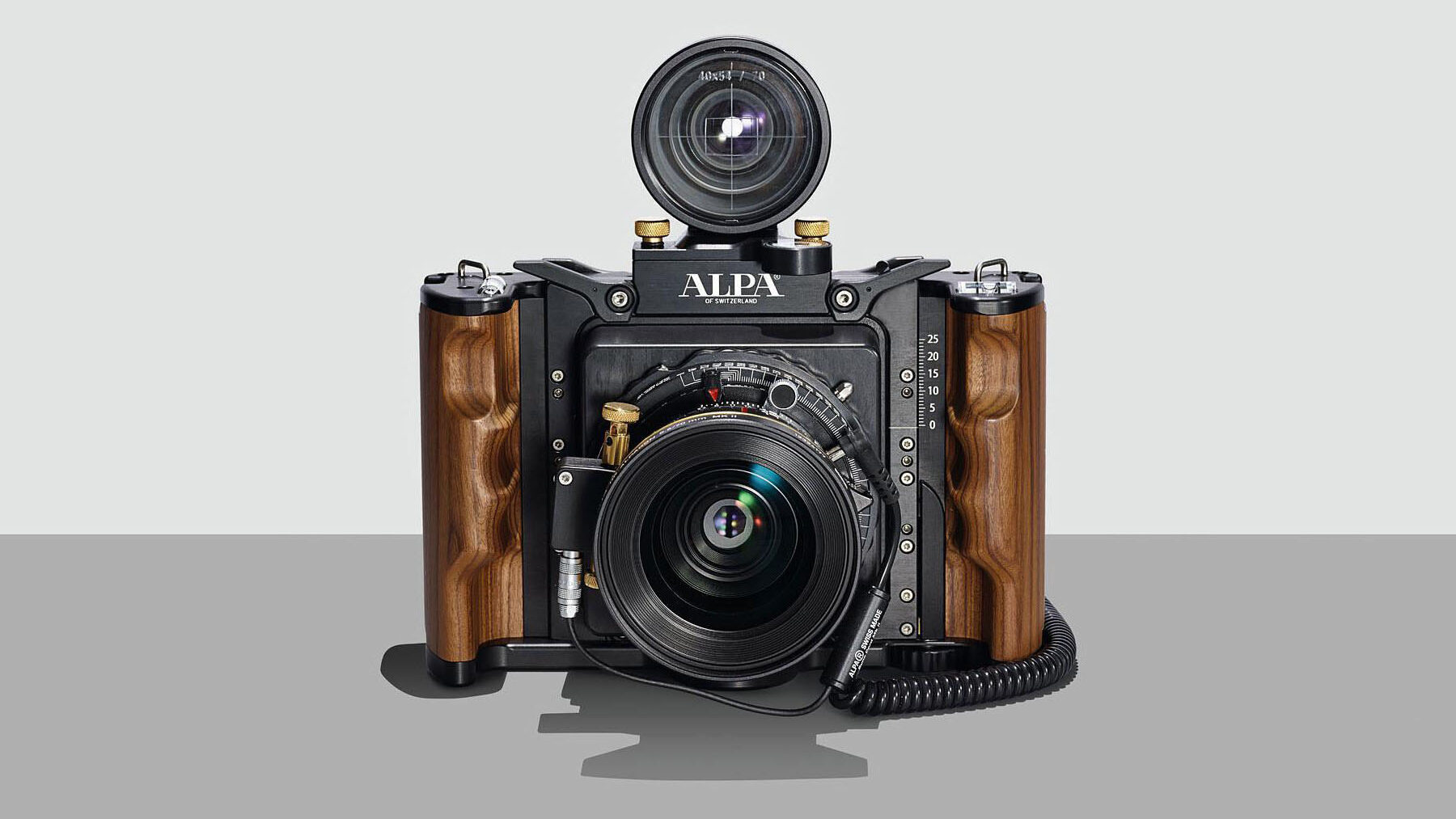
3. Current Manufacturers of Technical Cameras
Technical cameras have a long history that dates back to the 19th century with the basic functionality still being in use for modern camera models. While researching for this article I discovered, that all current technical camera manufacturers are situated in Central Europe: Arca-Swiss in France, Cambo in the Netherlands, Alpa in Switzerland, Linhof in Germany, Sinar in Switzerland and PhaseOne in Denmark. Three of these companies offer an especially wide range of cameras. Arca-Swiss and Cambo both offer various types of View-, Field and Flatbed Cameras while Alpa offers an extensive range of just Flatbed Cameras.
- Arca-Swiss: Known for their high-precision technical and view cameras, including models like the Rm3di and the F- and M-Line series.
- Cambo: Produces a range of technical cameras such as the WRS-1600 and the Actus series, designed for both digital backs and mirrorless cameras.
- Alpa: Swiss manufacturer known for precision-engineered technical cameras like the Alpa 12 STC, Alpa 12 Max, and Alpa 12 Plus.
- Linhof: Offers traditional and durable technical cameras, including the Linhof Master Technika, Technikardan and especially for digital backs the Linhof Techno.
- Sinar: Sinar was acquired by Leica in 2013. I heard that Sinar has discontinued the production of new lenses and cameras. Unfortunately I was not able to contact the company to get any feedback on their lineup.
- Phase One: The Phase One XT camera is built by Cambo and based on the design of the Cambo WRS system. So phase one is technically a reseller of Cambos technical cameras. The very travel friendly Phase One XT, which integrates seamlessly with Phase Ones IQ4 digital backs but is only compatible with the IQ4 lineup and special Rodenstock and Cambo lenses. 3°-5° tilt can be added with some of Phase Ones XT lenses.
These manufacturers are well-regarded in the industry for their quality and precision, making them reliable choices for photographers seeking technical cameras. Following you find the most precious piece of this article, a list of all currently manufactured technical cameras that I was able to research. I hope this gives you a better overview of which models to consider for your individual needs.
| Type | Compatibility | Size (HxWxL) | Weight (kg) | Shift | Rise/Fall | Swing | Tilt | Price | |
| ARCA-SWISS Pico | Bellow | mirrorless, digital backs | 19.2cm x 12cm x 17cm / 7.6in x4.7in x 6.7in | 1.13kg / 2.5lb | ±20mm rear, geared | ±20mm, geared | ±10°, geared | ±10°, geared | €3,890.00 |
| ARCA-SWISS F-Classic | Bellow | 4×5, 5×7, 6×9, 8×10, digital backs, mirrorless, roll film | 28cm x 19cm x 15cm / 11in x 7.5in x 5.9in | 2.8kg / 6.2lb | ±50mm front and rear | +85mm front and rear | ±360° front and rear (ltd. by bellows) | ±35° front and rear | €3,685.00 |
| ARCA-SWISS F-Metric | Bellow | mirrorless, digital backs, 4×5, 5×7, 6×9 8×10, roll film | 25cm x 16cm x 15cm / 9.8in x 6.3in x 5.9in | 2.6kg / 5.7lb | ±30mm front and rear, geared | +60mm front and rear, geared | ±360° front and rear (ltd. by bellows) | ±35° front and rear | €5,035.00 |
| ARCA-SWISS M-Monolith | Bellow | mirrorless, digital backs, 4×5, 5×7, 6×9, 8×10 | 33cm x 16cm x 15cm / 13in x 6.3in x 5.9in | 4.2kg / 9.3in | ±50mm front and rear, geared | +70mm front and rear, geared | ±45° front and rear, geared | ±45° front and rear, geared | €6,095.00 |
| ARCA-SWISS M-Two | Bellow | mirrorless, digital backs, 4×5, 6×9 | 33cm x 16cm x 25cm / 13in x 6.3in x 9.8in | 2.4kg / 5.3lb | ±35mm rear, geared | ± 35mm rear, geared | ±45° front, geared | ±15°, front, geared | €3,483.00 |
| ARCA-SWISS Rm3di | Flatbed | mirrorless, digital backs, roll film, 6×9 | 20.8cm x 19.6cm / 8.2in x 7.7in | 1.07kg / 2.36lb | ±15mm, geared | 30mm rise, 20mm fall both geared | turn tilt by 90° | ± 5°, geared | €4,499.00 |
| ARCA-SWISS Factum | Flatbed | mirrorless, digital backs, roll film, 6×9 | 15.5cm x 13.7cm / 6.1in x 5.4 in | 0,64kg / 1.4lb | turn camera by 90° | ±15mm, manual | turn tilt by 90° | ± 5°, geared | €3,544.00 |
| Cambo WRS-5000 | Flatbed | digital backs | 17.5cm x 19cm / 6.9in x 7.5in | 1.2kg / 2.6lb | ±22.5mm, geared | 25mm rise, 15mm fall, geared | none | none | €5,384.00 |
| Cambo WRS-1600 | Flatbed | digital backs | 16cm x 18cm / 6.3in x 7.1in | 0.92kg / 2.02lb | ±20mm, geared | ±20mm, geared | none | none | €3,897.00 |
| Cambo WRS-1250 | Flatbed | digital backs | 16.5cm x 17.8cm / 6.5in x 7in | 1kg / 2.2lb | ±20mm | 25mm rise, 15mm fall, geared | none | none | €3,421.00 |
| Cambo WRC-400 | Flatbed | digital backs | 14,5cm x 12cm / 5.7in x 4.7in | 0.5kg / 1.1lb | ±20mm | turn camera by 90° | none | none | €2,463.00 |
| Cambo Actus-B Mini | Bellow | mirrorless fullframe (no Nikon Z or Leica SL) | 17cm x 10cm x 15cm / 6.7in x 3.9in x 5.9in | 1kg / 2.2lb | ±20mm, rear, geared | 12mm rise, 15mm fall, rear | +10° and -9° front, geared | 360° front, geared | €2,130.00 |
| Cambo Actus-DB2 | Bellow | digital backs | 21cm x 10cm x 18cm / 8.3in x 3.9in x 7.1in | 1.2kg / 2.6lb | ±20mm, rear, geared | 12mm rise, 15mm fall, rear | +10° and -9° front, geared | 360° front, geared | €3,123.00 |
| Cambo Actus-G | Bellow | mirrorless fullframe and medium format, digital backs | 17.1cm x 11.5cm x 15.2cm / 6.7in x 4.5in x 6in | 1.15kg / 2.53lb | ±20mm, rear, geared | 12mm rise, 15mm fall, rear | +10° and -9° front, geared | 360° front, geared | €4,282.00 |
| Cambo Actus MV | Bellow | mirrorless fullframe and medium format, digital backs | 28cm x 12cm x 20cm / 11in x 4.7in x 7.9in | 2.8kg / 6.17lb | ±20mm front and rear, geared | ±15mm front and rear, geared | ±30° front, geared | ±15° front and rear, geared | €5,018.00 |
| Cambo Actus XL-35 | Bellow | mirrorless fullframe, digital backs | 34cm x 14,5cm x 31cm / 13.4in x 5.7in x 12.2in | 4.8kg / 10.6lb | ±25mm front and rear, geared | ±20mm front and rear, geared | ±20° front and rear, geared | ±20° front and rear, geared | €6,104.00 |
| ALPA 12 STC | Flatbed | digital backs | 14cm x 14,5cm x 2.5cm / 5.5in x 5.7in x 1in | 0,59kg / 1.3lb | ±18mm, shift guides made of brass with click stops, geared and free run | ±18mm rise or fall by turning camer 90°, geared and free run | 5°-10° with adapter for ALPA lenses with short barrel | 5°-10° with adapter for ALPA lenses with short barrel | €4,625.00 |
| ALPA 12 Max | Flatbed | digital backs, medium format film backs | 20.5cm x 18cm x 3cm / 8.1in x 7.1in x 1.1in | 1.2kg / 2.6 | ±18mm, shift guides made of brass with click stops, geared and free run | 25mm rise, 18mm fall, shift guides made of brass with click stops, geared and free run | 5°-10° with adapter for ALPA lenses with short barrel | 5°-10° with adapter for ALPA lenses with short barrel | €6,816.00 |
| ALPA 12 SWA | Flatbed | digital backs, medium format film backs | 18cm x 11.5cm x 4.5cm / 7.1in x 4,5in x 1.8in | 0,64kg / 1.4lb | 25mm rise, 25mm fall with adapter, geared | none | 5°-10° with adapter for ALPA lenses with short barrel | 5°-10° with adapter for ALPA lenses with short barrel | €6,630.00 |
| ALPA 12 TC | Flatbed | digital backs, medium format film backs | 11cm x 11cm x 2cm / 4.3in x 4.3in x 0.8in | 0,22kg / 0.5lb | none | none | 5°-10° with adapter for ALPA lenses with short barrel | 5°-10° with adapter for ALPA lenses with short barrel | €2,191.00 |
| ALPA 12 FPS* | Flatbed | digital backs, 6×4.5 film backs | 11.5cm x 20.5cm x 3.5cm / 4.5in x 8.1in x 1.4in | 0,75kg / 1.7lb | none | none | 5°-10° with adapter for ALPA lenses with short barrel | 5°-10° with adapter for ALPA lenses with short barrel | €8,861.00 |
| APLA 12 PLUS | Flatbed | digital backs | 18.4cm x 18.4cm x 2.5cm / 7.2in x 7.2in x 1in | 1.04kg / 2.3lb | ±20mm, shift guides made of brass with click stops, geared and free run | ±20mm, shift guides made of brass with click stops | 5°-10° with adapter for ALPA lenses with short barrel | 5°-10° with adapter for ALPA lenses with short barrel | €8,347.00 |
| Linhof M 679cs | Bellow | EF, F, E, X, G, digital backs, roll film | 29.4cm x 15.3cm x 17cm / 11.6in x 6in x 6.7in | 4.5kg / 9.9lb | ±38mm – ±168mm depending on bellow extension | ±38mm – ±168mm depending on bellow extension | ±30° front and back | ±45° front and back | €7,050.00 |
| Linhof Techno | Bellow | EF, F, E, X, G, digital backs, 4×5, 6×9 | 19.7cm x 17.6cm x 12cm / 7.8in x 6.9in x 4.8in | 1.9kg / 4.2lb | ±10mm front | +20mm front | ±10° front | ±10° front | €5,990.00 |
| Linhof Kardan re 4×5 | Bellow | 4×5 | 29cm x 25.5cm x 47cm / 11.4in x 10in x 18.5in | 3.9kg / 8.6lb | ±70mm, front and back | ±55mm, front and back | none | +30°, -40° front and back | €2,370.00 |
| Linhof Master Technika classic | Bellow | 4×5 plates or roll film | 18cm x 18cm x 11cm / 7.1in x 7.1in x 4.3in | 2.6kg / 5.7lb | ±40mm front | +55mm front | ±15° front | ±30° front | €7,260.00 |
| Linhof Technikardan S 6×9 | Bellow | EF, F, E, X, G, digital back, roll film up to 6×9 | 21cm x 16.5cm x 12.5cm / 8.3in x 6.5in x 4.9in | 2.8kg / 6.2 | 31mm left and 25mm right, front and back | ±50mm front and back | 360° | 360° | €4,460.00 |
| Linhof Master Technika 3000 | Bellow | EF, F, E, X, G, digital back, 4×5 roll film and plates | 18cm x 18cm x 11cm / 7.1in x 7.1in x 4.3in | 2.55kg / 5.6lb | ±40mm front | +55mm front | ±15° front, ±20° back | ±30° front, ±20° back | €6,980.00 |
| Sinar p3-df | Bellow | EF, F, Leica S, digital backs (Sinar, Leaf, Hasselblad V/H, Mamyia 645 AFD) | n/a | 5.1kg / 11.2lb | 30mm left, 50mm right, front and back | +40mm, -20mm, front and back | ±50° ungeared, front and back | ±19° geared, ±45° ungeared, front and back | €8,572.00 |
| Sinar LanTec | Flatbed | digital backs: Sinar, Mamyia, Hasselblad V/H | 20cm x 19cm x 7cm / 7.9in x 7.5in x 2.8in | 1.1kg / 2.4lb | ±20mm | +25mm, -15mm | none | none | €3,772.00 |
| Phase One XT** | Flatbed | Phase One IQ4 | 16cm x 14.8cm / 6.3in x 5.8in | 0.7kg / 1.5lb | ±12mm | ±12mm | none | none | €8,318.00 |
* The ALPA 12 FPS has an integrated focal plane shutter with shutter speeds ups o 1/4000 second, control of leaf shutters and aperture control.
So, what do we learn from this list? I definitely underestimated the number of options that you have when choosing a technical camera. And this is not the end of the market. During my research, I also discovered brands like Chamonix, Gibellini or Shen-Hao but I could not find any options to adapt digital cameras to these systems.
So I have tried to consolidate your options a bit. I highlighted the top 5 cameras for each column in the chart. Two categories become immediately apparent: The small, lightweight, and cheaper cameras without a lot of movement and the big and heavy cameras with a huge amount of movement. But let’s get a bit more detailed in which camera might suit your needs:
- Film Shooters: You have all the options that you want and you can choose from any manufacturer. The limiting factor is the available lenses. All currently produced lenses rely on the camera’s shutter to expose a frame. Lenses with integrated leaf shutters like the Copal are only available as legacy lenses.
- Digital Back Shooters: You also have the choice between every manufacturer on this list and you can choose between bellow and flatbed systems. ALPA specializes in digital backs and for Phase One users the XT might be interesting.
- Mirrorless Shooters: Most companies offer new solutions for their full frame or medium format mirrorless digital users. Have a look at the ARCA-SWISS Pico, or Rm3di, the Cambo Actus B, G, MV or XL-35 or the Linhof 679, Techno, or Technikardan range. Mirrorless shooters should go for a view camera instead of a flatbed camera due to collision problems between the handle of the mirrorless camera and the rear frame of the flatbed camera.
- Extensive Swing and Tilt users: Here you need a bellow system like the Arca Swiss F or M line, the Cambo Actus MV or XL line, Linhofs 679 or Master Technika 3000 or the Sinar p3-df.
- Budget friendly options: You want to use a technical camera with some shifting and tilting options without breaking the bank? Have a look at the Cambo Actus B mini under 3,000€ or the ARCA-SWISS Pico or Cambo Actus G or MV under 5,000€.
- Travel friendly options: Technical cameras with movement but still lightweight? You might want to look at ARCA-SWISS Pico or Rm3di, the Cambo WRS 1600 or Actus B/ DB2 or G line, the ALPA 12 PLUS, the Sinar LanTec or the Phase One XT.
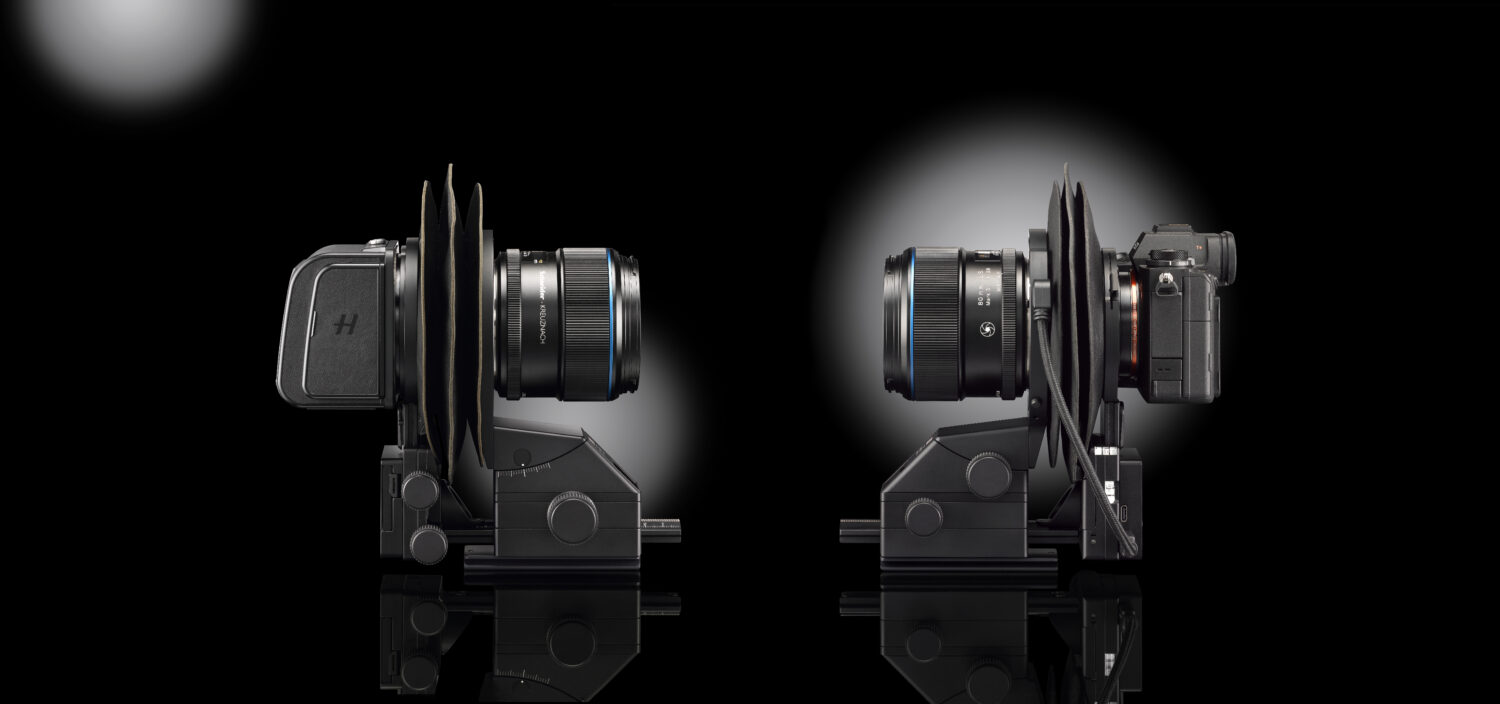
4. Digital Backs vs. Mirrorless Cameras
When choosing a digital camera for your technical camera, it’s essential to weigh the options between digital backs and mirrorless cameras, as well as the advantages of different sensor formats. Digital backs, particularly those from Phase One and Hasselblad, offer unmatched resolution, dynamic range, and color depth, making them ideal for professional architectural and landscape photography where detail and tonal range are paramount. These medium-format sensors have a larger sensor area, allowing less movement without vignetting. Digital backs are made for the combination with technical cameras. They offer the right ports to trigger lenses and fit on all types of bellow- or flatbed systems. With new advancements like live view, focus peaking and tethering to computers and iPads in the latest digital backs it is now easier than ever to use a technical camera in a digital workflow. With digital backs, you have just two options to go for:
- Phase One IQ4: This back offers you 150MP on a real medium format sensor with high dynamic range and has options for Trichromatic or Achromatic versions that range between 39.000€ and 51.000€. In this back you get a multitude of image stitching options and the highest image quality available from any consumer camera available. But with this also come some drawbacks like slower operation, short battery life and an overall camera experience from 2018.
- Hasselblad CFV100C: This camera was released in early 2024. It uses a cropped 100MP medium format sensor similar to the Hasselblad X2D or Fujifilm GFX 100 series. It is a very compact camera with a smooth operating system, a built in 1TB SSD and all the connections that you assume from a current camera. It produces 16bit photos with very fine details and can also be used as a mirrorless camera with Hasselblad’s XCD lens lineup. The CFV 100C comes in at a price of 7.799€
Mirrorless cameras, available in APS-C, full-frame and medium format, offer portability, flexibility and cost-effectiveness. You can use them easily with or without a technical camera system. Full-frame mirrorless cameras strike a balance with high resolution and good dynamic range, suitable for many professional applications. APS-C sensors, while more affordable and portable, offer lower resolution and dynamic range, making them less ideal for high-end technical photography. Medium-format mirrorless cameras, can also provide high resolution and dynamic range, bridging the gap between traditional digital backs and more portable systems. The big problem with mirrorless cameras is their built structure. Due to their hand grips they often interfere with the bellows of technical cameras and can not be used with flatbed cameras. The second problem is the recessed sensor inside the camera. By widening the distance between the sensor and the lens it is not possible to bring the bellow system close enough together to focus wide-angle lenses to infinity (also look at Flange-Focal-Distance for more information). This is why many technical camera systems only offer compatibility of mirrorless cameras and large format lenses from 45-50mm onwards.
Roundup of Key Points:
- Digital Backs: Highest resolution, dynamic range, color depth; ideal for professional use; perfectly built for technical cameras
- Mirrorless Cameras (Full-Frame): Good balance of resolution and dynamic range; portable and cost-effective; suitable for many professional applications, limited wide-angle lens choice for large format lenses, not usable with flatbed cameras. This smaller sensor offers more shift capabilities for the same image circle of a lens.
- Mirrorless Cameras (APS-C): Affordable and portable; lower resolution and dynamic range; less ideal for high-end technical photography, limited wide-angle lens choice for large format lenses, not usable with flatbed cameras.
- Medium-Format Mirrorless Cameras: High resolution and dynamic range; a middle ground between digital backs and more portable systems, limited wide-angle lens choice for large format lenses, not usable with flatbed cameras.
6. Technical Camera vs. Tilt-Shift-Lenses
Technical cameras offer several significant advantages over using tilt-shift lenses on a mirrorless camera, particularly for professional architectural, landscape and product photography. Firstly, technical cameras provide a greater range of movements, including tilt, shift, rise, fall, and swing, allowing for precise and significant adjustments to perspective and focus. In contrast, tilt-shift lenses are typically limited to tilt and shift movements. For example, the widely used Canon TS-E 24mm F73.5L II offers ±12mm of shift and 8.5° of tilt. Additionally, technical cameras can accommodate lenses with larger image circles, which enable more extensive shifts without vignetting, providing flexibility that tilt-shift lenses cannot match.
The modular design of technical cameras allows for easy switching between different lenses, backs, and accessories, without removing the camera from the tripod. This enhances customization and adaptability for various photographic needs. Moreover, technical cameras offer unparalleled control over the plane of focus with independent movements of the front and rear standards, making it easier to achieve extensive depth of field or selective focus effects.
The main advantage of a view camera versus T/S lenses is framing efficiency. Thanks to the independent and combinable movements, a view camera is much faster to frame with. Sometimes T/S lenses can turn to a headache to reach the same results. Another big benefit of technical cameras is, that the shift, rise and fall happen at the camera. The lens stays perfectly in place which means absolutely no movement of the image and therefore perfect stitches even for subjects that are directly in front of the lens. Also, tilt and swing are perfectly aligned with the lenses optical axis which means no change in perspective when you use this function.
Key advantages of technical cameras compared to tilt-shift-lenses:
- Comprehensive Movements: Independent adjustments of movements for precise control over perspective and focus.
- Large Image Circle: Enables significant shifts without vignetting, enhancing flexibility.
- Modular Design: Easy switching between different components for high customization. Although I have to say that full-frame tilt-shift lenses are also widely compatible with mirrorless APS-C, full frame and cropped medium format cameras through adapters.
- Detailed Focus Control: Independent front and rear standard movements for an unparalleled plane of focus control.
- Professional Integration: Seamless compatibility with high-resolution digital backs and optimized for long exposure and studio use.
- Macro Capabilities: For technical cameras, the minimum focus distance is defined by how long the bellow can be extended. This means that you can focus much more closely on the subject than with any DSLR or mirrorless system lens.
Advantages of tilt-shift-lenses over technical cameras:
- Portability: Tilt-shift lenses are much smaller and lighter than their large format counterparts plus the technical camera that they need. You have to plan at least with +1kg of weight for your overall camera system.
- Cost: Full-frame tilt-shift-lenses range from 2,000€-3,000€ and are therefore much cheaper than large format lenses (6,000-13,000€) and technical cameras (2,000€-9,000€).
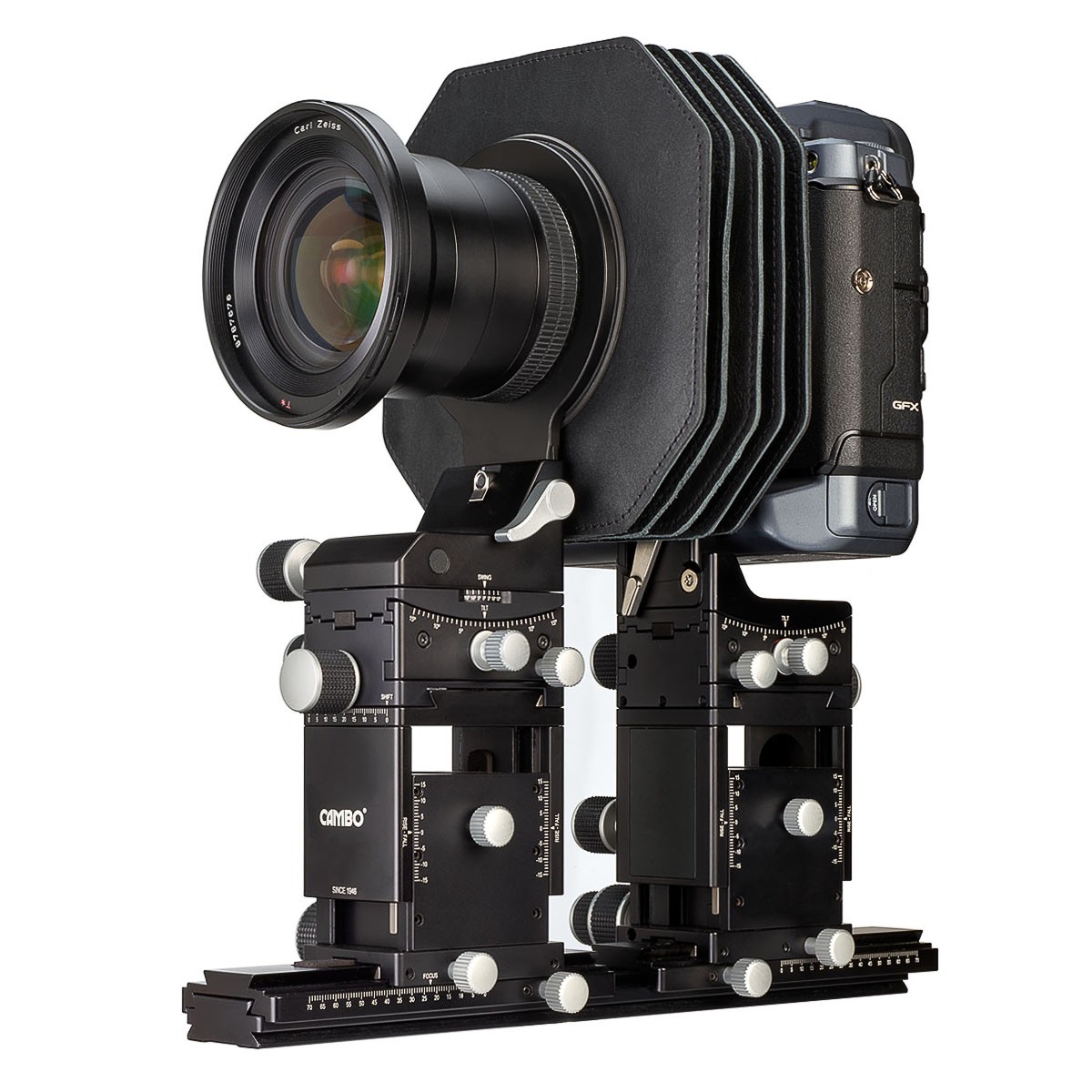
7. Choosing the Right Lens
Let’s continue with the topic of lenses. Selecting the appropriate lens for a technical camera is crucial to achieving optimal image quality and versatility. There are two primary types of lenses to consider: vintage lenses and those from current manufacturers. Vintage lenses like the Schneider Kreuznach Apo-Symmar, Rodenstock Sironar-N, Nikkor W Series, and Fujinon CM-W Series are renowned for their optical quality and can often be found at more affordable prices. The only current manufacturer of large format lenses is Rodenstock with its HR-Digaron lens series, which are specifically designed for digital use and provide superior performance with high-resolution sensors.
When it comes to overall lens quality, user opinions vary widely. You will find tests that show full-frame tilt-shift lenses offering higher resolution and less chromatic aberrations than their large format counterparts. This is why some technical camera manufacturers started to rehouse lenses from Canon or Nikon to make them usable with their cameras. (Arca-Swiss and Cambo). These lenses are usually much cheaper than large format Rodenstock HR-Digaron lenses, but they don’t offer a wide enough lens circle to allow for the lens movements that technical cameras offer. This, of course, varies with the sensor size that you use. Canon tilt-shift lenses offer ±12mm of shift in all directions for full-frame sensors. For cropped medium format sensors this is around 9mm and for APS-C sensors about 18mm of shift. Also, these new lenses from ARCA-SWISS and Cambo offer the possibility to use wide angles lenses like a15mm or 20mm with mirrorless cameras due to their specific lens design. Rodenstock lenses can only be adapted from 45mm onwards to mirrorless cameras.
Types of Shutters
- Focal Plane Shutter: All mirrorless cameras except from Hasselblad offer a mechanical focal lane shutter which allows the camera to adjust the shutter time internally. This shutter offers very fast speeds up to 1/8,000th of a second With these cameras you can use all lenses that you get in your hands.
- Leaf Shutter: A leaf shutter is situated inside the lens. It offers flash sync at all shutter speeds but usually tops out between 1/500th to 1/4000th of a second but, as you see, this shutter type is not as fast as a focal plane shutter and your camera relies on the mechanics of the lens to take a picture. Traditionally, large format lenses were supplied with a mechanical leaf shutter. Until a few years, mostly the ones made by Copal. These shutters are indispensable to shoot film. Mechanical shutters for large format lenses aren’t available new anymore. If you’d like to get into analog large format photography, you’ve got to rely on legacy lenses. A few companies (Sinar, Schneider Kreuznach) manufactured electronic leaf shutters. These either required an external controller or a computer connection. Nowadays Phase One is the only manufacturer that offers a leaf shutter for large format lenses. It has the distinction of being fully operatable from the Phase One IQ4 digital back. This makes it a very user-friendly system to work with. The drawback is that it’s not compatible with any other digital back. Hasselblad also manufactures leaf shutter lenses, but only for their proprietary XCD mount cameras.
- Electronic Shutter: All modern mirrorless cameras offer electronic shutters. This shutter can also be used with every lens and allows for the fastest shutter speed of 1/16,000th of a second. The drawback is the read out speed of the camera. For medium format cameras that can be up to 0,3 seconds (Hasselblad CFV50C) which results in a distortion of any moving subject (rolling shutter). This is until a global electronic shutter will be available for all mirrorless cameras.
Image Circle Coverage
Image Circle Coverage is another critical topic for ensuring that the lens can accommodate the necessary camera movements (rise, fall, shift) without vignetting. Larger image circles are recommended for technical photography to allow more extensive adjustments. To calculate the movement options of your sensor-lens-combination you have to subtract the diagonal length of your sensor from the diameter of the image circle. The resulting number is your maximum movement in opposite directions. Generally speaking, you get more movement options with a smaller sensor size.
Manufacturers
Another consideration is the lens lineup that some technical camera manufacturers offer. These lenses are specificially designed for the brand’s cameras and usually only work with the company’s own systems:
- ALPA: Offers a wide range of 9 lenses ranging from 23mm to 180mm all produced by Rodenstock. Some of their lenses incorporate an X-Shutter for the PhaseOne IQ system
- ARCA-SWISS: Currently offers a 24mm and a 50mm lens for their new Pico-System. The lenses are rehoused Canon TS-E lenses that still have the option for tilt and focus on the lens.
- CAMBO: Has a range of 10 lenses ranging from 15mm to 120mm. The company has a unique position with this offering as the lenses are just 1/6th of the cost of a Rodenstock lens. But the lenses offer only a limited amount of movement (12-20mm for full frame cameras).
- Linhof: Doesn’t offer its own lenses.
- Phase One XT: Offers 8 lenses ranging from 23mm to 90mm. The lenses are manufactured by Rodenstock and 5 out of the 8 lenses offer you additional tilt (3°-5°) to the shift options of the back.
- Rodenstock: Is THE manufacturer of large format lenses in the market. Until 2019 they manufactured lenses with a leaf shutter called Copal 0. From 2019 onwards they manufacture aperture-only lenses (AO line) without a shutter or a sync terminal for strobe lighting. They also manufacture the X-Shutter lenses for the Phase One IQ4 system ranging from 32mm to 120mm.
- Sinar: The company offered two types of lenses. You can still find new lenses for purchase as long as the stock lasts. The Sinaron Digital E-Shutter lenses consist of whopping 15 lenses ranging from 23mm to 180mm and offer the widest variety of all manufacturers. The shutter has a maximum speed of 1/250th of a second and can be controlled via a control unit, a computer or an app. The Sinar CPL line offers a mechanical cobal shutter (leaf shutter) with up to 1/500th of a second and 18 lenses ranging from 23mm to 180mm.
Focal Length
The focal length should be chosen based on your specific needs of your photography and is dependent on the crop factor of your digital camera system. Be aware that mirrorless systems often have problems to focus to infinity with lenses wider that 45mm in combination with technical cameras. With APS-C cameras it is more difficult to find wide-angle lenses and with medium format cameras it is harder to get into the telephoto range (which is usually not an architectural photographers concern).
| APS-C (Factor 1.5) | Full-Frame (Factor 1) | Cropped Medium Format (Factor 0.8) | Medium Format (Factor 0.65) | |
| 20mm | 30mm | 20mm | 16mm | 13mm |
| 24mm | 36mm | 24mm | 19mm | 15mm |
| 30mm | 45mm | 30mm | 24mm | 19mm |
| 40mm | 60mm | 40mm | 32mm | 26mm |
| 50mm | 75mm | 50mm | 40mm | 32mm |
| 80mm | 120mm | 80mm | 64mm | 52mm |
| 105mm | 158mm | 105mm | 84mm | 68mm |
| 150mm | 225mm | 150mm | 120mm | 97mm |
| 250mm | 375mm | 250mm | 200mm | 162mm |
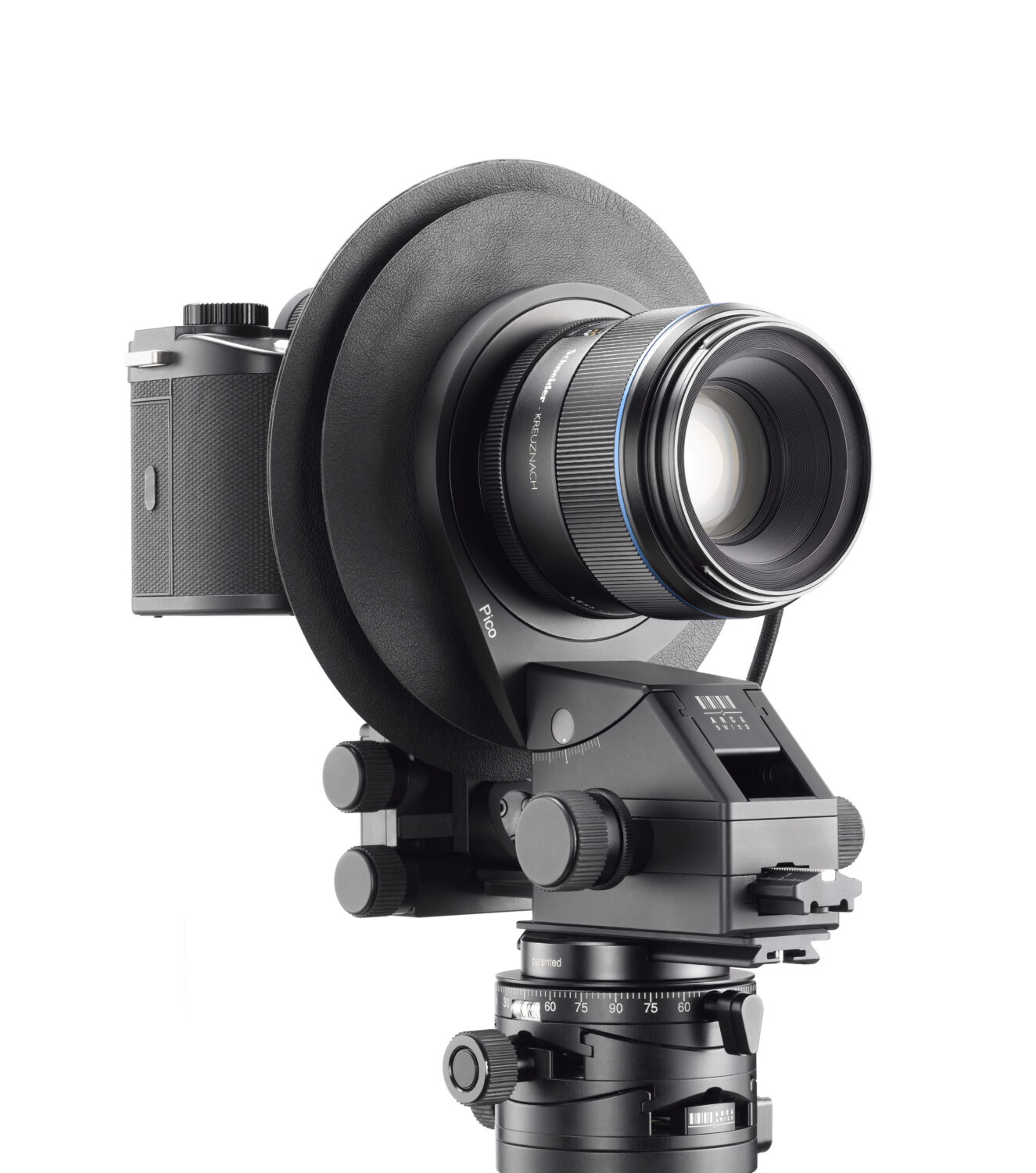
8. Summary
In this article, we explored the essential considerations for photographers new to technical cameras, focusing on their unique advantages and the necessary components for a complete system. Technical cameras, characterized by their extensive movements and high precision, are invaluable tools for architectural and landscape photography, offering unmatched control over perspective and depth of field.
We discussed the types of technical cameras, including view cameras, field cameras, and flatbed cameras, each suited to different scenarios. View cameras provide maximum control and image quality but are bulky and complex. Field cameras are portable and easier to use. Flatbed cameras balance precision and portability, ideal for versatile use in both field and studio settings.
When choosing between digital backs and mirrorless cameras for technical cameras, digital backs offer superior resolution and image quality but are expensive. Mirrorless cameras are more affordable and flexible, though they may lack the compatibility with technical cameras and lenses compared medium-format digital backs.
Selecting the right lens involves considering shutter types (leaf vs. mechanical), image circle coverage, and focal lengths are critical factors in achieving optimal performance and versatility.
Advantages of Using a Technical Camera System for Architectural Photography:
- Comprehensive Movements: Full range of adjustments that can be set individually for precise control over perspective and focus.
- Modular Design: Allows for easy customization and adaptation to different photographic needs.
- Detailed Focus Control: Independent front and rear standard movements provide unparalleled plane of focus control.
- Professional Integration: Seamless compatibility with high-resolution digital backs
- Composition: Fast and ultra precise framing of images with extensive shift, rise and fall
- Stitching: Perfect stitches of panoramic images due to no lens movement
- Macro Capabilities: For technical cameras the minimum focus distance is defined by how long the bellow can be extended.
Disadvantages:
- Cost: High expense, especially as a set of digital back, technical camera and large format lenses.
- Portability: Bulkier and heavier systems, which can affect field use.
- Complexity: More intricate setup and learning curve compared to standard DSLR or mirrorless systems.
- Maintenance: Requires careful handling and maintenance, particularly for delicate components like bellows and shutters.
Overall, technical cameras offer significant advantages in precision and image quality for architectural photography, making them a preferred choice for professionals despite their higher cost and complexity. This was my theoretical discourse about technical cameras. I am looking forward to trying out the ARCA-SWISS Pico system for myself in the near future and hopefully, I can give you a more practical review from there on. From my research, I think it is a very good tradeoff between size/ weight and movement range for my architectural photography which often involves hikes and lots of walking. This system also offers me the option to try my full-frame Canon R5, my medium format Hasselblad X2D and a Hasselblad CFV100C digital back with it.
What are your thoughts about the use of technical cameras in your daily working practice as an architectural photographer? I would love to hear your thoughts in the comments section. Also if you have any more insights and experiences to share about this topic, this is your time now!
If you have any suggestions about which lenses you use with your technical camera I would love to hear them, as this is one of the next topics that I am researching.
